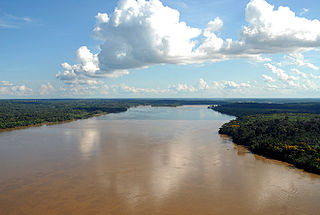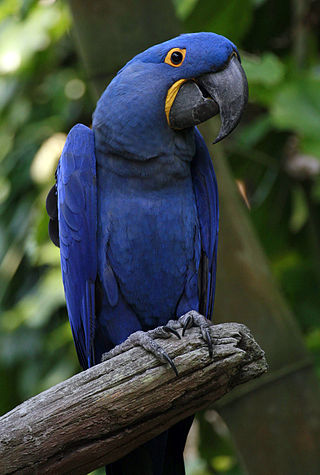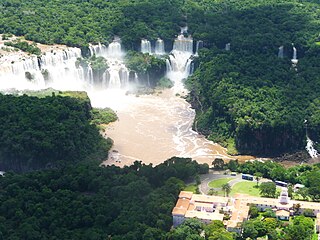This article relies largely or entirely on a single source .(April 2022) |

Conservation Strategy Fund (CSF) is a global conservation organization headquartered in Washington, D.C., with country offices in Bolivia, Brazil, Peru, Indonesia, and Kenya.
This article relies largely or entirely on a single source .(April 2022) |

Conservation Strategy Fund (CSF) is a global conservation organization headquartered in Washington, D.C., with country offices in Bolivia, Brazil, Peru, Indonesia, and Kenya.
Achievements include helping to establish 1.5 million acres of protected area in central Brazil, helping local people divert the construction of a road through Volcán Barú National Park in Panama, successfully preventing construction of a dam that would have flooded significant portions of Madidi National Park in Bolivia, and delaying the paving of highway BR-319 in the Brazilian Amazon which, without proper safeguards, could have inflicted harm on the world's largest rainforest. [1]

The Madeira River is a major waterway in South America. It is estimated to be 1,450 km (900 mi) in length, while the Madeira-Mamoré is estimated near 3,250 km (2,020 mi) or 3,380 km (2,100 mi) in length depending on the measuring party and their methods. The Madeira is the biggest tributary of the Amazon, accounting for about 15% of the water in the basin. A map from Emanuel Bowen in 1747, held by the David Rumsey Map Collection, refers to the Madeira by the pre-colonial, indigenous name Cuyari.
The River of Cuyari, called by the Portuguese Madeira or the Wood River, is formed by two great rivers, which join near its mouth. It was by this River, that the Nation of Topinambes passed into the River Amazon.

The Gran Chaco or Dry Chaco is a sparsely populated, hot and semiarid lowland natural region of the Río de la Plata basin, divided among eastern Bolivia, western Paraguay, northern Argentina, and a portion of the Brazilian states of Mato Grosso and Mato Grosso do Sul, where it is connected with the Pantanal region. This land is sometimes called the Chaco Plain.

The Pantanal is a natural region encompassing the world's largest tropical wetland area, and the world's largest flooded grasslands. It is located mostly within the Brazilian state of Mato Grosso do Sul, but it extends into Mato Grosso and portions of Bolivia and Paraguay. It sprawls over an area estimated at between 140,000 and 195,000 km2. Various subregional ecosystems exist, each with distinct hydrological, geological and ecological characteristics; up to 12 of them have been defined.

The hyacinth macaw, or hyacinthine macaw, is a parrot native to central and eastern South America. With a length of about one meter it is longer than any other species of parrot. It is the largest macaw and the largest flying parrot species; the flightless kākāpō of New Zealand outweighs it at up to 3.5 kg. While generally easily recognized, it could be confused with the smaller Lear's macaw. Habitat loss and the trapping of wild birds for the pet trade have taken a heavy toll on their population in the wild, so the species is classified as Vulnerable on the International Union for Conservation of Nature's Red List, and it is protected by its listing on Appendix I of the Convention on International Trade in Endangered Species of Wild Fauna and Flora (CITES).

The Cerrado is a vast ecoregion of tropical savanna in eastern Brazil, being present in the states of Goiás, Mato Grosso do Sul, Mato Grosso, Tocantins, Maranhão, Piauí, Bahia, Minas Gerais, São Paulo, Paraná and the Federal District. The core areas of the Cerrado biome are the Brazilian highlands – the Planalto. The main habitat types of the Cerrado consist of forest savanna, wooded savanna, park savanna and gramineous-woody savanna. The Cerrado also includes savanna wetlands and gallery forests.

Madidi is a national park at the upper Amazon river basin in Bolivia. Established in 1995, the park has an area of 18,958km². Together with the nearby protected areas Manuripi-Heath and Apolobamba and the Manu Biosphere Reserve (Peru), Madidi is part of one of the largest protected areas in the world.
Environmental issues in Bolivia include deforestation caused by commercial agriculture, urbanization, and illegal logging, and biodiversity loss attributed to illegal wildlife trade, climate change, deforestation, and habitat destruction. Since 1990, Bolivia has experienced rapid urbanization raising concerns about air quality and water pollution.
Noel Kempff Mercado National Park is a national park in northeast Santa Cruz Department, Province of José Miguel de Velasco, Bolivia, on the border with Brazil.

The Rainforest Foundation Fund is a charitable foundation founded in 1987 and dedicated to drawing attention to rainforests and defending the rights of indigenous peoples living there.

The Trust for Public Land is a U.S. nonprofit organization with a mission to "create parks and protect land for people, ensuring healthy, livable communities for generations to come". Since its founding in 1972, the Trust for Public Land has completed 5,000 park-creation and land conservation projects across the United States, protected over 3 million acres, and helped pass more than 500 ballot measures—creating $70 billion in voter-approved public funding for parks and open spaces. The Trust for Public Land also researches and publishes authoritative data about parks, open space, conservation finance, and urban climate change adaptation. Headquartered in San Francisco, the organization is among the largest U.S. conservation nonprofits, with approximately 30 field offices across the U.S., including a federal affairs function in Washington, D.C.

American Bird Conservancy (ABC) is a non-profit membership organization with the mission of conserving wild birds and their habitats throughout the Americas. Its focus is on threats to birds in the Western Hemisphere – threats which include overuse of pesticides, urban sprawl, habitat destruction, and invasive species.
Amazon Conservation Association (ACA) is a 501(c)(3) non-profit organization working to conserve the biodiversity of the Amazon basin through the development of new scientific understanding, sustainable resource management and rational land-use policy.

The Eduardo Avaroa Andean Fauna National Reserve is located in Sur Lípez Province. Situated in the far southwestern region of Bolivia, it is the country's most visited protected area. It is considered the most important protected area in terms of tourist influx in the Potosí Department.

Grand Canyon Conservancy, formerly known as Grand Canyon Association, is the National Park Service's official non-profit partner of Grand Canyon National Park, raising private funds, operating retail shops within the park, and providing premier guided educational programs about the natural and cultural history of the region. Supporters fund projects including trails and historic building preservation, educational programs for the public, and the protection of wildlife and their natural habitat.

The Jirau Dam is a rock-fill dam with an asphalt-concrete core, currently under construction on the Madeira River in the state of Rondônia, Brazil. The dam's hydroelectric power stations will have 50 turbines each 75 MW resulting total installed capacity of 3,750 MW. The power plant's first unit was commissioned in September 2013, the 16th in November 2014, 24th in February 2015, the 41st in December 2015, and the last in December 2016. Most of the power is designed to be exported to south-eastern Brazil via the Rio Madeira HVDC system.

The Santo Antônio Dam is a hydroelectric dam on the Madeira River 6 km (4 mi) southwest of Porto Velho in the state of Rondônia, Brazil. The dam's run-of-the-river hydroelectric power station have 50 turbines each rated at 71.6 MW resulting in a total installed capacity of 3,580 MW. The first unit began commercial production in March 2012, and as of June 2015 a total of 32 units were operational. Last 6 units went online in December 2016. Most of the power will be exported to south-eastern Brazil via the Rio Madeira HVDC system.

The Madeira-Mamoré Railroad is an abandoned railroad built in the Brazilian state of Rondônia between 1907 and 1912. The railroad links the cities of Porto Velho and Guajará-Mirim. It became known as the "Devil's Railroad" because thousands of construction workers died from tropical diseases and violence.
The 2011 Bolivian protests were a series of demonstrations by indigenous peoples who opposed the construction of the Villa Tunari – San Ignacio de Moxos Highway through the Isiboro Sécure National Park and Indigenous Territory, the ancestral lands of over 12,000 indigenous residents, from the Chimane, Yuracaré, and Mojeño-Trinitario peoples. The subcentral TIPNIS, the Confederation of Indigenous Peoples of Bolivia (CIDOB), and the highland indigenous confederation CONAMAQ—supported by other indigenous and environmental groups—organised a march from Trinidad, Beni to the national capital La Paz in opposition to the project, beginning on 15 August 2011.

The Trinational Biodiversity Corridor is a proposed ecological corridor that would link protected areas in the Alto Paraná Atlantic forests ecoregion in Brazil, Paraguay and Argentina.
Ximena Vélez Liendo is a Bolivian conservation biologist whose work focus on the ecology of the Andean bear, known as jukumari in aymara language, and its conservation in Bolivia and the rest of South America.